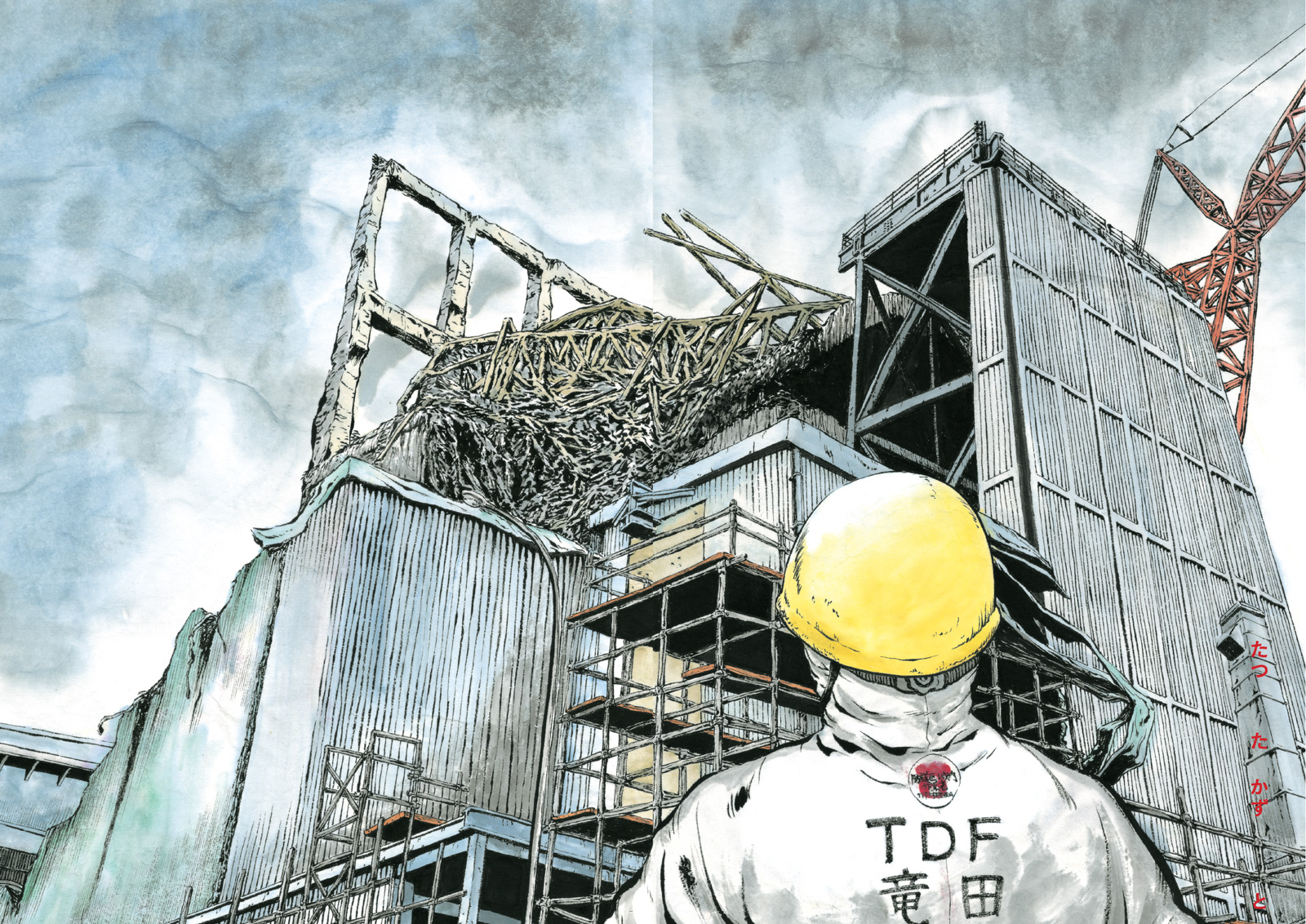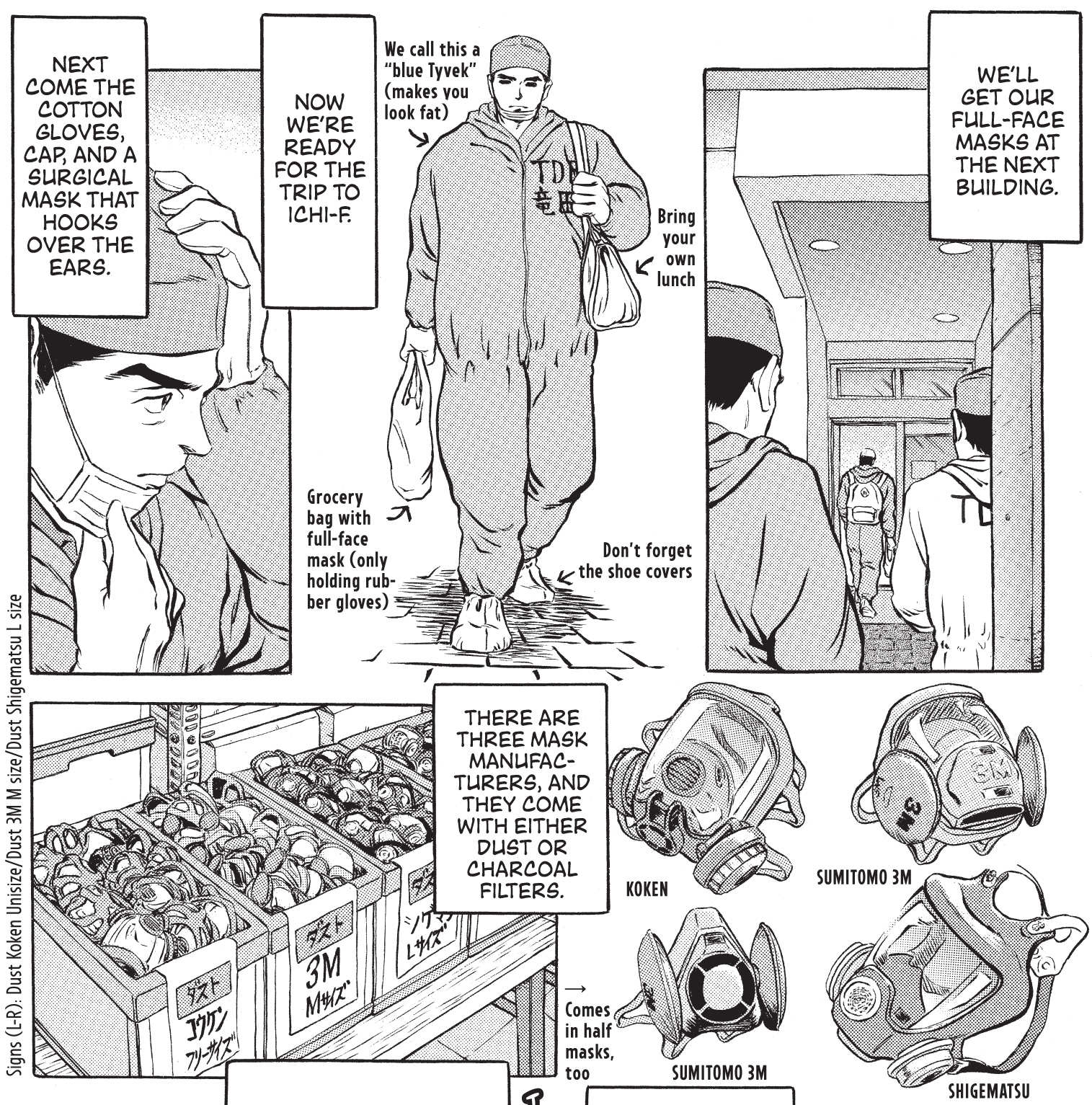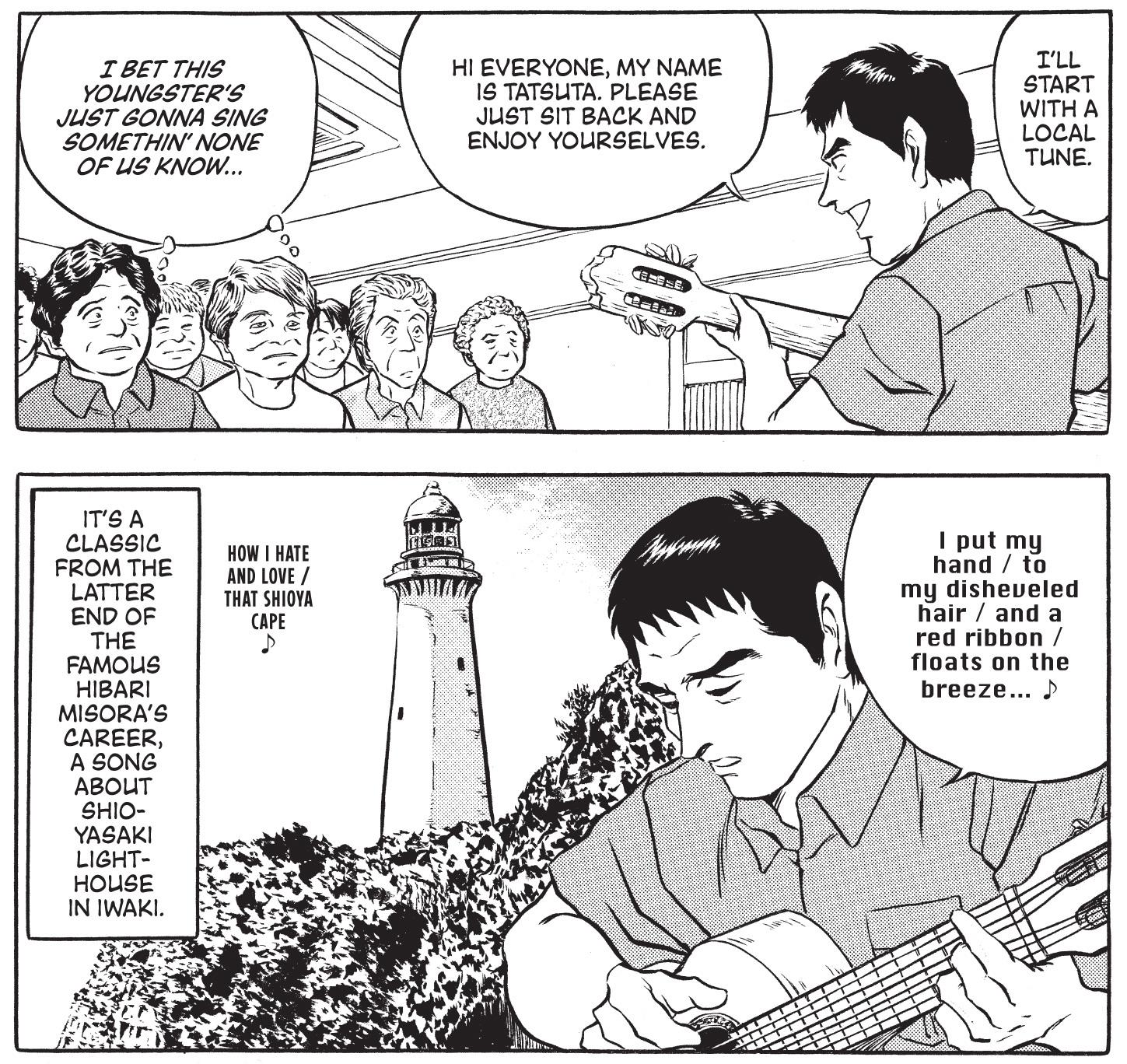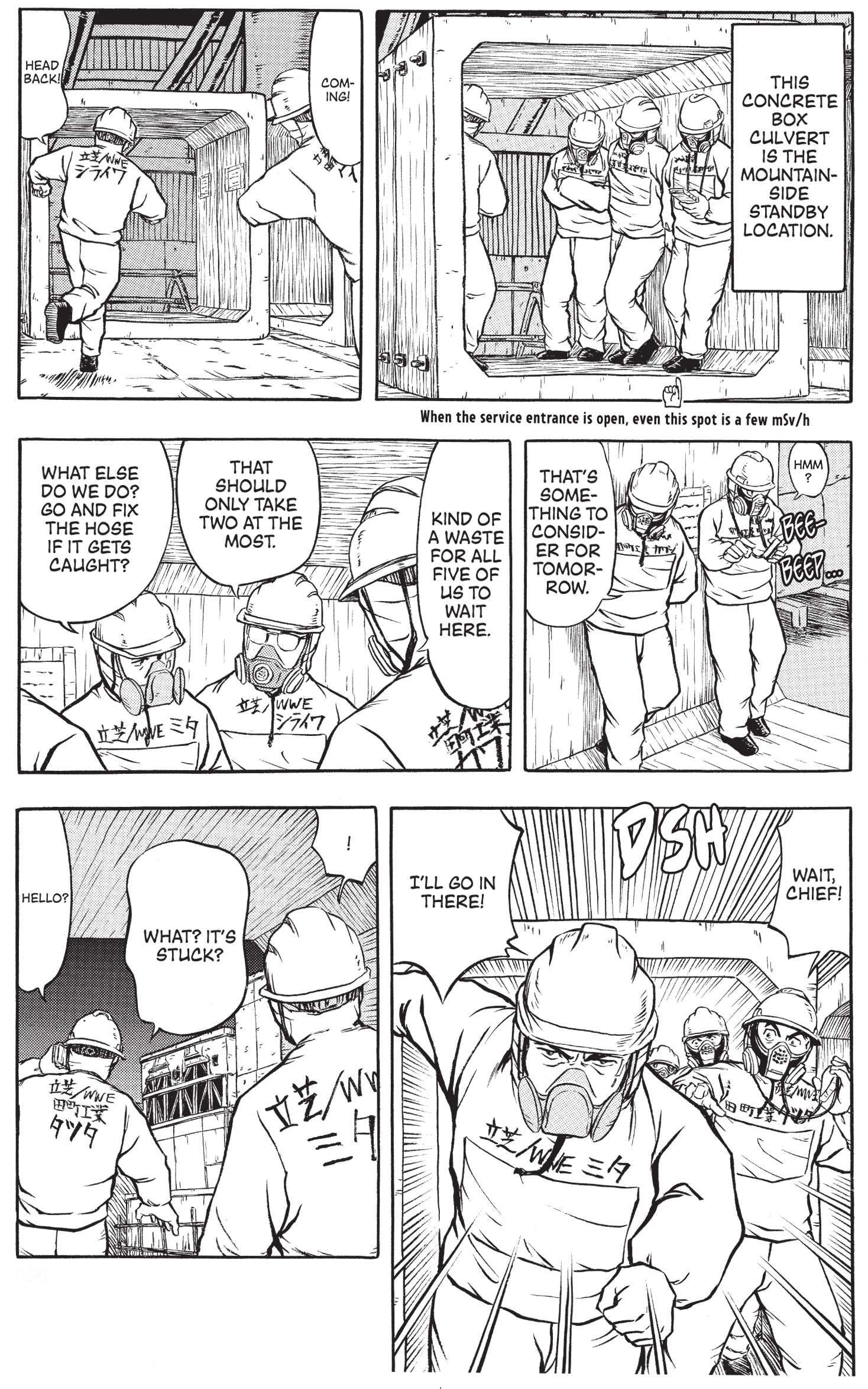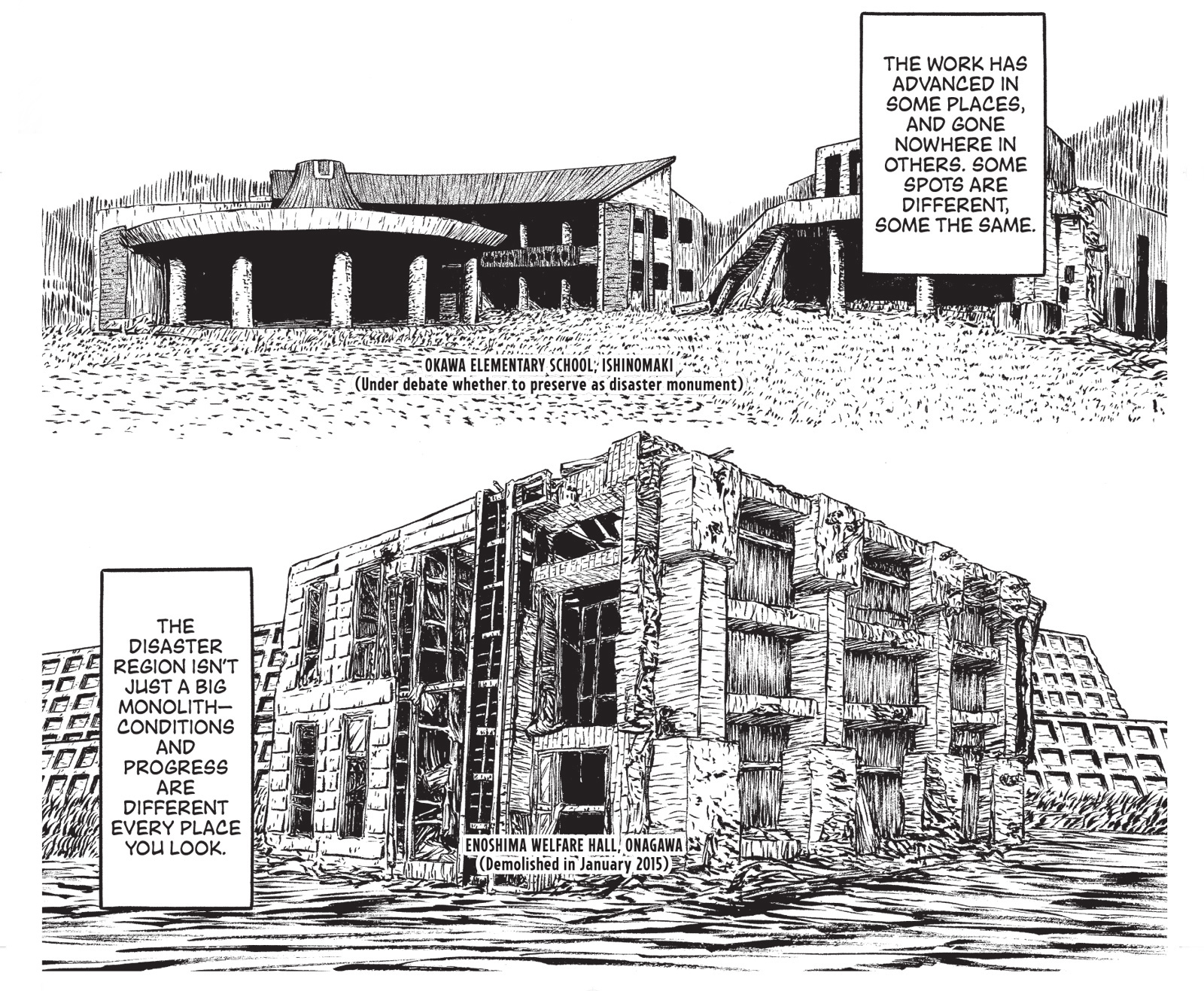Kazuto Tatsuta’s Ichi-F: A Worker’s Graphic Memoir of the Fukushima Nuclear Power Plant occupies a unique position in the history of comics. It is probably the first work of journalistic comics in the world to supersede its prose counterparts as the most popular source on its topic. In the case of Ichi-F, that topic is the cleanup and decommissioning work at the crippled Fukushima Daiichi nuclear power plant, the local name of which (“F-1,” flipped to “1-F”) gives the book its title.
The publisher of the English edition, Kodansha Comics, however, has opted to call this 550-page tome of dry, detailed reportage a “graphic memoir,” presumably because autobiography seems the easiest way to sell literary-minded comics outside the young-adult market these days. The original Japanese subtitle describes the manga instead as a “rōdōki,” literally a “record of labor,” putting more emphasis on the work itself than the person doing the work. The difference might seem trivial, but it speaks to many of the things that Ichi-F both succeeds and fails in doing.
Based on three stints as a temporary laborer at the Daiichi facility—the first in the second half of 2012 and then two stints over a few months in 2014—Ichi-F is a peculiar kind of exposé. “I told myself, if there really was a ‘hidden truth of Fukushima’ like they said, I’d go there and see what it was for myself,” Tatsuta says near the start of the book, as he begins looking for jobs at the plant through Tokyo-based employment agencies. But from the beginning it is clear that he’s not looking for dirt. As Tatsuta pulls back the dark veil surrounding what was supposedly the most toxic place in the world, the landscape he reveals is unexpectedly and refreshingly bland. With clear, diagrammatic visuals and plenty of worksite chatter, Tatsuta narrates the typically long days of menial janitorial and construction work, as well as the tedious but necessary safety measures—from the different types of protective suits, gloves, and masks that have to be worn depending on where one works, to the constant monitoring of one’s radiation exposure to ensure, not just health, but access to the maximum number of work hours. He also explains the subcontracting system that has efficiently recruited enough men (3,000 to 7,500 were on site on any given day in the years Tatsuta was there, with a high rate of turnover) to stabilize the plant, but has been widely criticized for diverting two-thirds or more of worker pay to middlemen.
True to its “memoir” tag, Ichi-F shows the author growing as an informed and conscientious citizen while working at the facility—though not in the direction we might expect from a book set after a meltdown. Tatsuta starts the book suspicious of antinuclear critics and protests; not a hundred pages in, he’s convinced they spout hogwash, at least on the subject of what is happening at ground zero. He likewise comes to the conclusion that media exposés about exploitative contracts, suicidally radioactive work conditions, and unreported worksite deaths are not only largely unfounded, but also detrimental to the progress of both the cleanup operations and the economic recovery of the surrounding region.
There are also warm episodes featuring him playing guitar at evacuee housing camps in the nearby city of Iwaki (where many of the Daiichi workers also stay) or being interviewed by the press after the first installments of his manga were published in Japan. But these personal detours are never truly confessional or introspective. Like Tatsuta’s repeated images of men furrowing their brow and getting down to work, then smiling when the job is done, they serve to display the narrator’s trustworthiness and approachability.
Though Tatsuta’s manga is not the only first-hand worker’s description of what has gone on in Fukushima (there are a handful of prose accounts), it is the one that gets referenced most frequently in Japan as a counterpoint to the many reports of worksite deaths (which are few, and none of which have had to do with radiation), worksite dangers (as Tatsuta shows, safety protocols are stringent and, with some exceptions in the immediate post-meltdown years, have been strictly enforced, such that heatstroke is today the biggest health concern), and worker exploitation through the subcontracting system. But Tatsuta’s nonchalance can be hard to swallow, especially given the long latency periods of radiation illnesses, the scandals involving underreported exposure doses, and a number of documented cases of companies abusing the subcontracting system to steal hazard pay and avoid government meddling in the event of workplace injuries. As important as worker safety and satisfaction are, Tatsuta’s singular focus on them tends to distract from some of the larger issues that surround Fukushima Daiichi.
Advertisement
Paternalism is a serious problem when it comes to nuclear matters in Japan, as in other countries. It was, and continues to be, a central trait of the corporatist state that insisted on nuclear power against strong regional resistance (often led by women), and created the conditions for the meltdowns by cutting corners and ignoring warnings in the first place. You have to look hard for the women in Ichi-F. There’s one, a female reporter, on page 320: “Wow, what a looker!” says Tatsuta’s coworker. Meanwhile, his colleagues circulate unnerving rumors of women in TEPCO (Tokyo Electric Power Company, operator of the Daiichi facility) uniforms, in managerial positions no less—this in a chapter set as late as 2014. Tatsuta criticizes anti-nuclear hysteria, but that is hardly the only ideology that skews perception of what is going on in Fukushima.
For example, the areas near Daiichi are now being developed as centers for a new “decommissioning industry” offering good jobs with stable employment and high pay, with R&D facilities to make Japan a global leader in nuclear decontamination, waste processing, and reactor decommissioning. These initiatives are being touted as both necessary for post-disaster remediation and beneficial to the region’s long-term recovery. High hopes are being placed in robotics, which is being used to measure radiation and remove debris in highly contaminated environments, as illustrated in the last chapters of Ichi-F. News reports suggest, however, that this is not going well, with frequent technical failures caused by frighteningly high radiation near the melted fuel.
The irony, which Tatsuta fails to comment on, is that decommissioning is being led by the same companies that built and operated Japan’s nuclear plants: Hitachi GE, Toshiba Westinghouse, and Mitsubishi Heavy Industries, for example, as well as large construction corporations like Shimizu, Kashima, and Takenaka. French nuclear giant Areva is also involved, through a joint venture with the Japanese company Atox, which specializes in nuclear facility maintenance and waste disposal. Tatsuta is happy to share the details of his own paycheck and outline the general workings of the subcontracting system that swallows up most of the money laid out by the government and TEPCO for post-disaster labor costs. But he keeps the names of his employers and the master contractors anonymous. Likewise, when he depicts the billboard affixed to the face of Daiichi’s entry facility, which is emblazoned with the logos of the major companies involved, the text is rendered so indistinctly that only a few names can be made out.
Tatsuta clearly doesn’t care where the money goes (back to the nuclear and construction industry) or where it originally came from (taxpayers and energy consumers). He fails to see that, when Japan signed up for nuclear power in the 1950s, it made a deal with the devil; because of the technical complexity, security issues, political interests, and capital-intensiveness involved in nuclear power, the country now has no choice but to ask its jailor for deliverance. No amount of masculine sweat and good-natured smile will change that. When the decommissioning at Daiichi is due to take at least until 2050 and cost at least 21.5 trillion yen (189 billion USD), should the radiation exposure doses of individual workers—a subject that takes up a good chunk of Ichi-F—really be the only numbers we’re concerned with? And with fifty-some aging and halted reactors in Japan, Fukushima itself is just the beginning.
Ichi-F has sold hundreds of thousands of copies in Japan and been celebrated extensively in the press. American, French, German, and other foreign reporters interviewed Tatsuta even before translations of his manga appeared. Despite this fame, the public knows little about the artist beyond the restricted window he provides in Ichi-F. “Kazuto Tatsuta” is a pseudonym, and all photographs show him disguised in a Mexican wrestling mask. He claims that he originally hid his identity so that he would be able to work at the plant again. But this shroud of secrecy, along with Tatsuta’s tendency to dismiss antinuclear voices while giving TEPCO and the Japanese government a free pass, has led some to suspect the author of being a lackey of the nuclear industry.
His workaday drawing and layout style does suggest past experience with made-to-order manga from corporate, institutional, or educational clients, but that doesn’t prove anything. Late in the book, he offers a peek onto his professional past with a panel showing a sampling of sports, “documentary” (about what?), and trashy “true stories” comics for “cheapo convenience store mags.” We know, through press reports, that Tatsuta was in his late forties when he drew Ichi-F, so one assumes a fairly extensive resume of past comics work; what would that oeuvre reveal about his politics and associations if we knew his real name and could look it up? Alas, all we are really shown about Tatsuta is that he earnestly believes in what he sees with his own eyes, in the merits of hard work, and in the good intentions and dedication of his workmates and their employers. And he seems to be adverse to any of the personal or political reflection that transforms a report or recollection into a worthwhile memoir, or for that matter into a persuasive work of journalism.
Advertisement
Some find Ichi-F insufficiently angry. I certainly do. But it’s worth remembering what the climate was like in Japan when Tatsuta began drawing Ichi-F in 2013. The meltdown was still an ongoing event, even if things were no longer in a state of apocalyptic emergency. The public worried about what was happening and what would happen. They looked to the press for help, only to have to wade through obfuscations from officials and half-truths from muckrakers. Passionate misinformation was still the norm, and people were exhausted by the instability it was causing in their lives. Some citizens had already taken matters into their own hands by creating radiation hot-spot maps and working directly with farmers and organic produce collectives to figure out what was safe to eat, or where to live or let their children play. Radiological dosimetry and nuclear risk assessment became home sciences, and Geiger counters mass consumer goods. While other artists and writers raged about what lurked behind radiation’s cloak of invisibility, Tatsuta worked in parallel with activists and researchers (many of whom would probably disagree with his politics otherwise) who endeavored to find ways to make the threat visible and knowable and, if not controllable, then at least navigable.
Ichi-F may not be beautifully drawn or eloquently written. The perspective may be narrow and at times politically naïve, even infuriating. But it does not succumb to the superficial, fear-mongering nonsense that infects so much post-Fukushima reporting and art, both inside and outside Japan, from bogus computer-generated images showing the Pacific Ocean as a contaminated cesspool to sculptural installations presenting the black sacks used for removing contaminated soil as if they were time bombs or body bags. As a result, Tatsuta has given us a book that actually matters, with information and perspectives that we can actually debate, and that people will be referring to long after the cloud of doom has passed.
Kazuto Tatsuta’s Ichi-F: A Worker’s Graphic Memoir of the Fukushima Nuclear Power Plant, translated into English by Stephen Paul, is published by Kodansha Comics.


